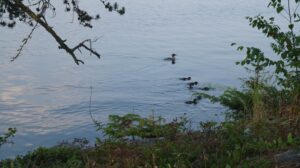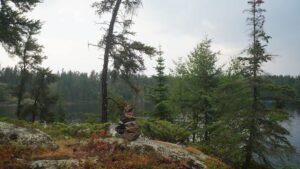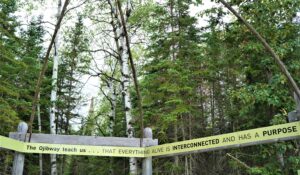Environmental Personhood as a Decolonizing Environmental Protection Strategy
By Amy Cherpako
What is environmental personhood?
Legal personhood, Rights of Nature, environmental personhood…This concept has many different names and applications all around the world. In recent years, this environmental protection strategy has gained momentum, throughout various countries’ domestic laws, legislative actions, and international legal systems, forging strong connections and interpretations of existing environmental laws and human rights.
The general ideology behind environmental personhood is attaining legal rights for natural entities, for the purpose of protection or preservation. More specifically, it involves a critical “paradigm shift” which places the natural environment as “a holder of the right to be protected, as opposed to an object of protection” (Cárdenas, 2000, para. 4). Therefore, natural entities have value in and of themselves, which is completely independent from its short-term value to human beings.
This idea was famously introduced into the Western legal system by Christopher D. Stone in his landmark 1972 article “Should Trees Have Standing? Toward Legal Rights for Natural Objects”. He argued that natural entities like trees and rivers should be granted legal rights, in the same way that corporations have legal rights and authority. He also proposed the use of legal guardians who can represent the natural entity in practical contexts.
However, viewing the natural world in this way was practiced long before Stone’s article. Indeed, many Indigenous peoples have complex, long-standing beliefs regarding the personification of nature.

How does environmental personhood relate to Indigenous worldviews?
Indigenous peoples around the world have diverse belief systems, cultures, spiritualities, and worldviews. However, there are some underlying, foundational patterns of values that relate to perceptions of the natural world, such as viewing some natural entities as personified, rather than inanimate. Some Indigenous worldviews also emphasize an inherent connection to the natural world as equal living parts of the ecosystem (Salmón, 2000), as well as a corresponding responsibility to protect the natural world and ensure sustainability. For example, the Seventh-Generation principle, which originated with the Iroquois peoples, “states that any action or decision should take into account its consequences for up to seven generations to come” (Ebel & Rinke, 2014, p. 82).
Worldviews like this have allowed Indigenous populations to thrive in a sustainable manner for millennia, developing Traditional Ecological Knowledge (TEK) and rich cultural and spiritual ways of life. However, Western scholars are just recently beginning to understand the implications and benefits of Indigenous knowledges within the context of scientific and political solutions. This is how environmental personhood provides a bridge between Western legal systems and Indigenous worldviews, in an embodiment of Two-Eyed Seeing.

Why are innovative strategies needed?
Indigenous peoples and their traditional territories around the world tend to be disproportionately affected by environmental degradation and exploitative resource extraction, including mining and hydropower operations. This is a continuing effect of colonizing, anthropocentric, and capitalistic ideologies, which prioritize the commodification of nature and corporate economic gain over Indigenous and environmental rights. This ideology enforces dominance over the natural world, often in an unsustainable manner.
These practices negatively affect Indigenous livelihoods and traditional ways of life which are intrinsically related to the land and natural resources, as well as a multitude of explicit and implicit effects on physical, mental, emotional, cultural, and spiritual wellbeing.
Unfortunately, Indigenous peoples are also typically excluded from domestic and international decision-making regarding environmental protection initiatives. Multilateral organizations such as the United Nations and the World Bank have been reluctant to “recognize the standing of Indigenous peoples and to allow their active participation and consultation” in a meaningful way (Havemann, 2016, p. 345).
All of these patterns are intricately intertwined with colonial undercurrents, as Indigenous peoples around the world continue to fight for their rights and land recognition against state powers, corporations, and exploitation of the natural world.

Why is environmental personhood a promising solution?
The environmental personhood model is different from other conservation strategies because it values the rights of nature independently from anthropocentric motives. It also provides opportunity to legally enhance Indigenous land stewardship, as many protected natural entities have Indigenous groups appointed as legal guardians, who are entrusted with the enforcement of its legal rights.
As the emphasis is placed on the entity itself and its relation to Indigenous stewards, this increases Indigenous autonomy and self-determination, rather than relying on perpetual, unbalanced negotiations with governments and corporations.
For example, the Innu of Ekuanitshit First Nation band have strived for generations to protect the Magpie River or Muteshekau Shipu from hydroelectric dam development by Hydro-Québec. This river has important cultural value to the community related to their traditional land-based practices.
On February 23, 2021, the Muteshekau Shipu became the first river in Canada to be granted legal personhood. The river now has nine legal rights, and the Innu Council of Ekuanitshit are appointed as its legal guardians. David Boyd (UN Special Rapporteur on Human Rights and the Environment) described this protection as “a recognition of the importance of integrating Aboriginal legal concepts into the Canadian legal system” (as cited in Cárdenas, 2021, para. 5).
The Innu of Ekuanitshit First Nation peoples have proven that attaining environmental personhood is possible within Canada. As education and awareness about this journey is shared, there is potential for more Indigenous communities across Canada to use environmental personhood in their own territories.
References
Cárdenas, Y. V. (2021, March 9). The recognition of the Magpie/Muteshekau Shipu River as a non-human person. International Observatory on the Rights of Nature. https://www.observatoirenature.org/post/the-recognition-of-the-magpie-muteshekau-shipu-river-as-a-non-human-being
Ebel, A., & Rinke, T. (2014). Listening to the voices of young and future generations. In State of the world 2014: Governing for sustainability (pp. 82-90). Island Press. https://doi.org/10.5822/978-1-61091-542-7_8
Havemann, P. (2016). Indigenous peoples’ human rights. In M. Goodhart (Ed.), Human rights: Policy and practice (3rd ed., pp. 333-350). Oxford University Press.
Salmón, E. (2000). Kincentric ecology: Indigenous perceptions of the human-nature relationship. Ecological Applications, 10(5), 1327–1332. https://doi.org/10.1890/1051-0761(2000)010[1327:KEIPOT]2.0.CO;2
Stone, C. D. (1972). Should trees have standing? Toward legal rights for natural objects. Southern California Law Review, 45(2), 450-501. https://heinonline-org.uml.idm.oclc.org/HOL/Page?lname=&public=false&collection=journals&handle=hein.journals/scal45&men_hide=false&men_tab=toc&kind=&page=450
Resources for Further Reading
- Center for Democratic and Environmental Rights – Rights of Nature Legal Training (https://www.centerforenvironmentalrights.org/rights-of-nature-legal-training)
- Bioneers – Rights of Nature (https://bioneers.org/rights-of-nature-media-collection/)

